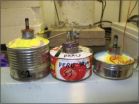(Press-News.org) CHAMPAIGN, Ill. — The small kerosene lamps that light millions of homes in developing countries have a dark side: black carbon – fine particles of soot released into the atmosphere.
New measurements show that kerosene wick lamps release 20 times more black carbon than previously thought, say researchers at the University of Illinois and the University of California, Berkeley. The group published its findings in the journal Environmental Science and Technology.
Black carbon is a hazard for human health and the environment, affecting air quality both indoors and out. It has a major impact on climate as it absorbs heat and sunlight, warming the air. Although it only lingers in the atmosphere for about two weeks, one kilogram of black carbon can cause as much warming in that short time as 700 kilograms of carbon dioxide circulating in the atmosphere for 100 years, according to study leader Tami Bond, a professor of civil and environmental engineering at the U. of I.
"There's a lot of interest right now in reducing black carbon as a quick way to reduce climate warming – a way to reduce warming in the immediate future, although not a full solution to long-term climate change," Bond said. "In its short lifetime of two weeks, it adds a lot of energy to the atmosphere. It's immediate warming now, which is why people are talking about reducing it."
Previously, emissions researchers did not consider kerosene lamps a large source of black carbon because of the relatively small amount of fuel used in a lamp verses other particle-emitting sources, such as cookstoves or diesel engines. However, the new measurements from the field show that 7 to 9 percent of fuel burned is converted to black carbon – a very high emission factor, making such lamps a major source of black carbon. In addition, unlike the cocktail of aerosol particles released by cookstoves and cooking fires, the dark curls rising from a kerosene lamp are nearly pure black carbon.
The good news is that there are inexpensive, easy alternatives that could curb black carbon emissions from lamps. For example, LED lamps charged by solar panels are becoming more popular. But an even easier fix would be to place a glass shield around the lamp, which reduces – though does not eliminate – the amount of black carbon particles that escape.
"Unlike cooking stoves, which also are very important health hazards but challenging to replace, people actually like to replace the kerosene lamps," Bond said. "When it comes to lamps, nobody says, 'I really like this tin can that I filled with kerosene.' It's a plausible, inexpensive way to reduce climate warming immediately, which is something we haven't really had in the black carbon field before."
The study authors hope that, with the new data in hand, agencies working in developing countries will implement lamp-replacement initiatives to develop and distribute affordable alternatives.
"Getting rid of kerosene lamps may seem like a small, inconsequential step to take," said study lead author Nicholas Lam, a UC Berkeley graduate student, "but when considering the collective impact of hundreds of millions of households, it's a simple move that affects the planet."
INFORMATION:
The Centers for Disease Control and Prevention, the National Institute of Environmental Health Sciences, the U.S. Agency for International Development and the Environmental Protection Agency supported this research.
Editor's note: To reach Tami Bond, call 217-244-5277; email yark@illinois.edu. The paper, "Household Light Makes Global Heat: High Black Carbon Emissions From Kerosene Wick Lamps," is available online.
The dark side of kerosene lamps: High black-carbon emissions
2012-12-11
ELSE PRESS RELEASES FROM THIS DATE:
Intensified chemotherapy shows promise for children with very high risk form of leukemia
2012-12-11
Young patients with an aggressive form of leukemia who are likely to relapse after chemotherapy treatment can significantly reduce those odds by receiving additional courses of chemotherapy, suggest the findings of a clinical trial led by investigators at Dana-Farber/Children's Hospital Cancer Center in Boston.
The trial leaders will present the results of the Dana-Farber Cancer Institute ALL Consortium study, which involved nearly 500 patients under age 18 with B-precursor acute lymphoblastic leukemia (B-ALL), at the annual meeting of the American Society of Hematology ...
As Amazon urbanizes, rural fires burn unchecked
2012-12-11
Over past decades, many areas of the forested Amazon basin have become a patchwork of farms, pastures and second-growth forest as people have moved in and cleared land--but now many are moving out, in search of economic opportunities in newly booming Amazonian cities. The resulting depopulation of rural areas, along with spreading road networks and increased drought are causing more and bigger fires to ravage vast stretches, say researchers in a new study. The study, focusing on the Peruvian Amazon, is the latest to suggest that land-use changes and other factors, including ...
Blood levels of immune protein predict risk in Hodgkin disease
2012-12-11
Blood levels of an immunity-related protein, galectin-1, in patients with newly diagnosed Hodgkin lymphoma reflected the extent of their cancer and correlated with other predictors of outcome, scientists reported at the American Society of Hematology annual meeting.
In a study of 315 patients from a German database, researchers from Dana-Farber Cancer Institute found that serum galectin-1 levels "are significantly associated with tumor burden and additional adverse clinical characteristics in newly diagnosed Hodgkin lymphoma (HL) patients."
The measurements were made ...
Conservatives can be persuaded to care more about the environment
2012-12-11
When it comes to climate change, deforestation and toxic waste, the assumption has been that conservative views on these topics are intractable. But new research from the University of California, Berkeley, suggests that such viewpoints can be changed after all, when the messages about the need to be better stewards of the land are couched in terms of fending off threats to the "purity" and "sanctity" of Earth and our bodies.
A UC Berkeley study has found that while people who identified themselves as conservatives tend to be less concerned about the environment than ...
Before 'Skyfall': 46 years of violence in James Bond movies
2012-12-11
Violent acts in James Bond films were more than twice as common in Quantum of Solace (2008) than in the original 1962 movie Dr No, researchers from New Zealand's University of Otago have found.
The researchers analysed 22 official franchise films, which span 46 years, to test the hypothesis that popular movies are becoming more violent (The latest Bond film, Skyfall, was not included as it was unreleased at the time of the study).
They found that rates of violence increased significantly over the period studied and there was an even bigger increase in portrayals of ...
NASA satellites see Typhoon Bopha fizzle over weekend
2012-12-11
Infrared data from NASA's Aqua satellite have watched the strong thunderstorms in Typhoon Bopha fizzle and shrink in area over the weekend as wind shear increased. Bopha has now dissipated in the South China Sea, just west of Luzon, Philippines.
NASA's Aqua satellite has been providing data on Bopha since the day it formed on Nov. 26. In the storm's last days, Aqua's Atmospheric Infrared Sounder (AIRS) instrument captured infrared data of the storm and showed that cloud top temperatures warmed from Dec. 8 through Dec. 9 as cloud heights fell and thunderstorms lost their ...
NASA gets eyeballed from Cyclone Claudia
2012-12-11
NASA's Aqua satellite got "eyeballed" from Cyclone Claudia in the Southern Indian Ocean when two instruments captured the storm's eye in infrared and visible light. Satellite data indicates that Claudia's eye is about 10 nautical miles wide.
On Dec. 10 at 0841 UTC (3:41 a.m. EST), NASA's Aqua satellite's Atmospheric Infrared Sounder (AIRS) instrument captured an infrared view of Cyclone Claudia which showed a clear eye surrounded by powerful thunderstorms. The thunderstorms that surrounded the eye were high in the troposphere and cloud top temperatures topped -63 Fahrenheit ...
Experimental graft-vs.-host disease treatment equivalent to standard care in Phase 3 trial
2012-12-11
An experimental drug combination for preventing graft-versus-host disease (GVHD) was not significantly better than the standard regimen on key endpoints, according to a report of a phase 3 trial at the American Society of Hematology annual meeting.
The combination of two immunosuppressive compounds -- tacrolimus plus sirolimus -- did not provide a statistically significant, GVHD-free survival benefit over the long-used standard of care, tacrolimus plus methotrexate, said researchers from Dana-Farber Cancer Institute who led the multi-center trial.
However, there were ...
Messages that speak to conservatives' morals narrow partisan gap on environment
2012-12-11
Public opinion on environmental issues such as climate change, deforestation, and toxic waste seems to fall along increasingly partisan lines. But new research suggests that environmental messages framed in terms of conservative morals — describing environmental stewardship in terms of fending off threats to the "purity" and "sanctity" of Earth and our bodies — may help to narrow the partisan gap.
A study from researchers at UC Berkeley has found that while people who identified themselves as conservatives tend to be less concerned about the environment than their liberal ...
Health-care practitioners must cooperate to reduce medication mismanagement, MU expert says
2012-12-11
COLUMBIA, Mo. – Medication reconciliation is a safety practice in which health care professionals review patients' medication regimens when patients transition between settings to reduce the likelihood of adverse drug effects. It is among the most complex clinical tasks required of physicians, nurses and pharmacists, who must work cooperatively to minimize discrepancies and inappropriate medication orders. Now, a University of Missouri gerontologiccal nursing expert suggests that acknowledging practitioners' varying perspectives on the purpose of medication reconciliation ...



